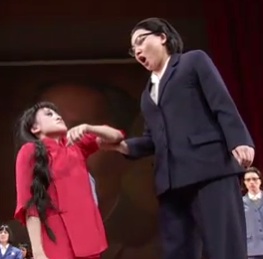A woolly mammoth nicknamed Snuffy, a stuffed tiger with a philosophical bent, Humphrey Bogart as personal confidante—imaginary friends come in all shapes, sizes and species. All of these examples happen to come from mass media (TV, comics and film), but consider the following companions, as described by real-life children:

-
Rose, a female squirrel with brown fur and hazel eyes who lives in an equally imaginary house in the backyard
-
Fake Rachel, an 8-year-old girl with brown hair and freckles who lives under the bed
-
Elephant, a 7-inch-tall, 5-year-old female gray elephant who wears tank tops and shorts
-
Sergeant Savage, a 100-year-old GI Joe doll who wears boxing gloves, has a permanent Band-Aid on his forehead and is sometimes invisible even to the child who invented him
-
Robert, a black panther who lives in the jungle and first introduced himself to his human companion in a dream
Some pretend friends are invisible; others are based on toys. Some have magical powers, such as the ability to fly; some are everyday boys and girls, with occasional mean streaks. Some have blue skin, some have pet crocodiles, some are talking animals. Yet all are composed of pure imagination.
Over the past 20 years, UO psychology professor Marjorie Taylor has gathered reams of data on pretend friends, in her exploration of the why of imaginary companions: Why do children create them? What purpose do they serve? Are they a sign of superior creativity or of some confusion concerning the boundary between fantasy and reality—or maybe even both? She studies the development of the imagination and the deep connections between daydreaming and creativity, in both children and adults.
Children who interact with imaginary companions have routinely been viewed as peculiar, shy or troubled, said Taylor, and this negative perspective can still apply. Some parents wonder whether their child’s habit of spending time with an imaginary companion is a psychological red flag, an indication that the child is in emotional distress or is having trouble communicating with other children.
Popular culture often endorses this notion. Take a look at films in which a young, fantasy-prone character conjures make-believe companions or gets lost in a self-made imaginary world. Consider, for instance, young Danny’s diabolical invisible friend Tony in The Shining, or the sinister-looking, 6-foot-tall rabbit Frank in Donnie Darko. In these films and many others, the child who interacts with companions that only he or she can see is depicted as sad, withdrawn and in dire emotional straits—in short, in need of some serious psychological repair.
Such films typically end in one of two ways: the overly imaginative child meets an unfortunate end or makes friends with real children (often with the help of a well-meaning adult), relinquishing his or her imaginary friends and slamming the door on the lush make-believe world. The act of turning one’s back on the fantastic represents a return to normalcy, to good mental health.
But according to Marjorie Taylor, that’s just not true.
A four-year-old is friends with two make- believe birds, both named Nutsy, who live in a tree outside the child’s bedroom window. The child describes the birds as having brightly colored feathers, standing about 12 inches tall and talking constantly. “I met them myself one day when they accompanied the little girl to my lab,” said Taylor in her book Imaginary Companions and the Children Who Create Them (Oxford University Press, 1999). “I provided a chair for them, and the little girl laughed at how funny they looked as they stood on tiptoe to peer over the table at her.”
The reality, says Taylor, is that children who invent and maintain friendships with imaginary companions tend to be less shy, have an increased ability to focus their attention and display more empathy toward others than those without such companions. And this conjuring act is certainly not limited to a shy, reclusive few: In a 2004 study Taylor and colleagues discovered that 65 percent of seven-year- olds reported having had an imaginary companion at some point in their lives.
So, should parents be concerned if their kids don’t have imaginary friends? Fear not, says Taylor. “Despite some results suggesting that children with imaginary companions might be superior in intelligence, it is not true that all intelligent children create them.”
In other words, your average Calvin has the capacity to be a smart, well-adjusted child, with or without a corresponding Hobbes.
In collaboration with graduate student Deniz Tahiroglu, Taylor also studies the development of anthropomorphism—the tendency to interpret what is not human in terms of human characteristics.
To demonstrate the prevalence of anthropomorphism, Tahiroglu and Taylor show a brief video of geometric shapes— circles, squares, triangles—moving through space and sometimes interacting with each other: A triangle approaches a circle; they gently touch. To an adult observer, the act clearly conveys affection, even though the two objects are nothing more than shapes composed of pixels on a screen. They don’t even possess faces, smiley or otherwise.
The reality is that mental phenomena such as imaginary companions and anthropomorphism do not simply come to an end when childhood does. In fact, Taylor posits that the same cognitive processes that prompt children to conjure imaginary friends are also involved in the complex relationships that develop between fiction writers and the characters that they create for their stories and novels.
“Everyone does this,” said Taylor. “Adults anthropomorphize. We interpret movement of machines in terms of human beings. The question is: when—and why—does a child start doing this?”
A five-year-old girl began creating fantasies about dolphins when she was two years old. She would pretend to hold the miniature dolphins in her hands and give them to family members. After her parents gave her a small gray plush dolphin, the child invented an imaginary dolphin friend named Dipper. When Taylor asked the child to describe Dipper, she did not list the physical attributes of her toy but instead described her friend as being the size of a door, having sparkles and living on a star.
What prompts children to invent pretend friends? The primary reason, said Taylor, is that pretend friends provide tireless, on-the-spot fun and companionship. Often imaginary playmates will share a child’s interests and hobbies. They also provide an outlet for a child’s emotions, serve as proxies for communicating information to parents and play the role of fall guy when a child does something wrong.
Far from causing social or emotional problems, pretend friends can often help children deal with their fears and anxieties. For example, some children invent imaginary companions who are afraid of the dark, and the act of comforting their companions may help these children conquer their own fear. In fact, after looking at the data and considering her own experiences as a parent, Taylor began to wonder whether pretend friends confer upon their human companions more advantages than anyone ever suspected.
In other words, a dependable Hobbes can offer the average Calvin much more than witty banter and a stationary snowball target.
A three-year-old girl had developed a powerful fear of ghosts. The child was presented with a small box said to contain a “baby ghost” and was asked whether she wanted to take care of it. The child said yes and carried the box around with her for over a week, absorbed by the needs of her newfound, imaginary ward. Although she eventually abandoned the box for other toys, she was never again troubled by her fear of ghosts.

In the study, a child’s outcome was considered healthy if the individual graduated from high school, had no run- ins with the police, was not using illegal drugs and had not received a diagnosis of a psychological disorder. The conclusion? The 12-year-olds with imaginary companions had, on average, better outcomes as 18-year-olds than did their counterparts who enjoyed only flesh-and- blood friendships.
Another project, conducted in concert with the Oregon Social Learning Center and the Center for Research to Practice, is looking at foster care children who have been forced to move frequently from school to school. With graduate students Naomi Aguiar and Candice Mottweiler, Taylor is exploring the extent to which interactions with imaginary friends may be helpful to this socioeconomically disadvantaged group. “Some of these children created imaginary worlds, places of plenty,” she said. While the researchers’ analysis is yet to be completed, “We are interested in finding out if their interactions with pretend friends improved their resilience and ability to cope in high- risk situations.”
A parent learned that her son had an imaginary playmate named Nobby, whom the parent thought was a little boy. But when she asked her son how often he played with Nobby, he replied, “I don’t play with him.” Nobby turned out to be a 160-year-old businessman who visited the child between business trips to Portland and Seattle, whenever the child needed someone to talk to. “The boy’s mother was as surprised as we were,” said Taylor.
Evidence for the remarkable plasticity of children’s brains—their ability to summon pretend friends, for instance, as well as a gift for language acquisition—has spawned a cottage industry of products designed to boost Junior’s brainpower.
But the notion that the impressionable minds of young children can benefit from frequent exposure to such multimedia educational products as the Baby Einstein series is “misguided,” said Taylor. “There is a tendency among parents to use media as an electronic babysitter, but unstructured playtime is important,” she said.
There are no such electronic diversions in the Imagination Lab, a creativity- inspiring workspace littered with crayons, toys and construction paper, where Taylor and her graduate students interview three- to five-year-olds about their imaginary companions. The researchers use this space to investigate how fictional situations promote social understanding, and how this translates to real-world people and situations. They also have devised innovative methods for measuring creativity, such as presenting children with the beginning of a fictional story and instructing them to finish it. Some of the children Taylor has studied have demonstrated a remarkable ability to conjure whole imaginary worlds, complete with unusual flora and fauna, a bustling population and even an entirely made-up language.
Taylor, also the editor of The Development of Imagination (Oxford University Press, to be published in 2012), said she and graduate student Alison Shawber-Sachet were surprised to discover that children’s imaginary friends are far from perfect.
“Children would say things like ‘She’s mean,’ or ‘She won’t go away’ or ‘She keeps bossing me around.’ The common denominator was their uncontrollability.”
With UO colleagues Sara Hodges and Adele Kohanyi, Taylor noticed some of these same qualities when she interviewed fiction writers about their literary creations. “Fiction writers talk about battling with their characters. They say things like, ‘It was the character’s idea. I could have never come up with something like that.’ This is an illustration of individual agency.”

“It’s mental time travel,” she said. “It’s ubiquitous in the way people think.”
Creativity, a subset of the imagination, encompasses the fiction-loving moments of our lives, from idle daydreaming to active storytelling—activities we engage in every day. In fact, we spend significant chunks of our lives in the realm of fiction: we read novels, watch films and plays, and fantasize about what we will do when we inevitably win the Oregon Lottery.
In terms of the impact of these activities, “there is no cut-and-dried distinction between what is real and what is imaginary,” said Taylor. “What’s fictional can elicit real emotion.”
And therein lies the cornerstone of empathy, said Taylor. Empathy is what allows us to picture ourselves in another’s shoes, to understand another’s pain, to see the commonalities in one another instead of only the differences.
As the planet’s population continues to expand—potentially exceeding 10 billion by the year 2100 (not counting imaginary friends)—the demand for empathetic response becomes ever more complex. Imagination, therefore, is no mere time waster. It allows us to plan for the future, to foresee crises and devise ways to be prepared.
Or not—as illustrated several years ago by an imaginative little boy and his pretend friend:
Calvin: You can’t just turn on creativity like a faucet. You have to be in the right mood.
Hobbes: What mood is that? Calvin: Last-minute panic.


_24-thumb-150x144-1308.jpg)


 Watch
Watch  Watch excerpts from the opera, coming soon to Eugene.
Watch excerpts from the opera, coming soon to Eugene. 

 Three’s a charm for a living memorial.
Three’s a charm for a living memorial.